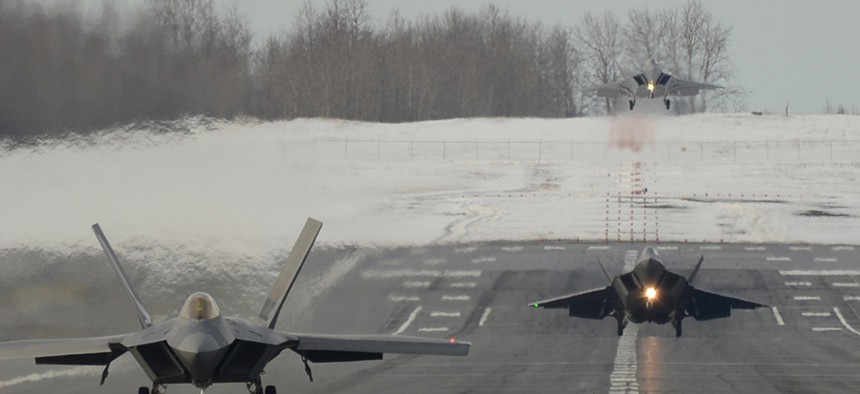
Three F-22s taking off from Elmendorf-Richardson in Alaska U.S. Air Force
The U.S. Military Is One Step Closer to Having Invisibility Cloaks
Nanotechnology solutions offer the promise of hiding in plain sight. By Patrick Tucker
Researchers are one step closer to creating shields that could render parked tanks and aircraft virtually invisible.
Debashis Chanda of the University of Central Florida and his fellow researchers have developed a technique to much more quickly create the “metamaterials” with the potential to bend light rays around objects, creating, in effect, invisibility.
In 2007, a group of engineers from Purdue University created a “cloak” design of cylindrically-arranged nano-needles that could deflect light around an object in somewhat the same way that light, when it hits water, bends around the object just beneath the surface, or a hot flat expanse, can create the illusion of water near desert horizon. Rays of light, composed of photons, change in shape depending on the atomic properties of the objects that they encounter. The Purdue researchers could hide only large stationary objects because of the design’s limits in terms of electromagnetic wavelength.
In the years since, researchers from around the world have made steady progress in metamaterial design. But metamaterial doesn’t exactly grow on trees. It has to be engineered at the nanoscale (one billionth of a meter in size) so creating enough of it to hide anything has been a challenge. Chanda and his fellow researchers have developed a technique that allows for the mass-production of metamaterial through a type of printing process.
The technique creates stacks of metallic dielectric wafers that then merge together, chemically, called nanotransfer. “You create a stack and then another stack and you actually grow them on top of each other chemically,” Chanda explained. H said he can use this technique to print 4 inch-by-4 inch areas of metamaterial that could, in principle, be altered to deflect light. The alternative method right now is having is assembling individual pieces of metamaterial, most no bigger than one millionth of a meter.
“Printing is high throughput based on a low cost nanotransfer printing technique,” Chanda said. “Other techniques don’t allow for an easy way of making multi-layer 3D metal/dielectric stacks.”
Getting from printed stacks to a point where it is possible to print enough material to hide large objects is a matter of scaling up the process.
The material that Chanda created can’t simply be slapped on top of a tank or plane to hide it but the printing process would allow for the faster creation of the sort of highly complex material with that capability. “You should be able to engineer that,” he said. “We looked to just engineer a bunch of properties over a big area.” One of those capabilities was partial invisibility. Specifcally, he says that the material that he and his fellow researchers made had a negative refractive index over the 400-625 nanometer wavelength range.
it could be used to hide large, stationary objects but probably not moving objects.
It’s a small but important step in the realization of a cloak to hide large objects out in the open. Just make sure to make a reminder about where you left your F-35.
Their paper is published in the March journal of Advanced Optical Materials.
NEXT STORY: Inside the Military’s New Office for Cyborgs





